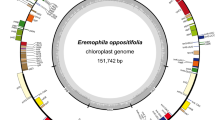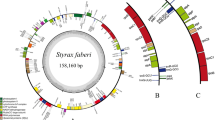Abstract
The sieve-element plastids of members of several genera in theBuxaceae (Buxus, Pachysandra andSarcococca) were found to be of the specific subtype PVI, which contains a central globular protein crystal.Simmondsia (Simmondsiaceae) andDaphniphyllum (Daphniphyllaceae), on the other hand, were found to contain S-type sieve-element plastids. The occurrence of the highly restricted PVI plastids in theBuxaceae mitigates against a close relationship between theBuxaceae andSimmondsia, Daphniphyllum andEuphorbiaceae. Exine sculpturing of theBuxaceae andSimmondsiaceae also shows no close similarities. Both of these EM characters are discussed in connection with other available data and with respect to earlier systematic treatment of these families.
Similar content being viewed by others
References
Baillon, H., 1859: Monographie des Buxacées et de Stylocérées. — Paris.
- 1877: Histoire des plantes, VI.
Bentham, G., Hooker, J. D., 1862–1883: Genera plantarum.
Behnke, H.-D., 1975: P-type sieve-element plastids: A correlative ultrastructural and ultrahistochemical study on the diversity and uniformity of a new reliable character in seed plant systematics. — Protoplasma83, 91–101.
—, 1977: Transmission electron microscopy and systematics of flowering plants. — Pl. Syst. Evol., Suppl.1, 155–178.
—, 1981: Sieve-element characters. — Nordic J. Bot.1, 381–400.
Bor, J., 1979: Pollen morphology and the bi-reticulate exine of thePhyllanthus species (Euphorbiaceae) from Mauritius and Réunion. — Rev. Palaeobot. Palynol.27, 149–172.
Cronquist, A., 1968: The Evolution and Classification of Flowering Plants. — London: Nelson.
—, 1979: A list of classes, subclasses, orders, and families of the angiosperms. — In:Jones, S. B., Luchsinger, A. E., (Eds.): Plant Systematics, Appendix 3. — New York: McGraw-Hill.
Dahlgren, R., 1975: A system of classification of the angiosperms to be used to demonstrate the distribution of characters. — Bot. Notiser128, 119–147.
—, 1980: A revised system of classification of the angiosperms. — Bot. J. Linn. Soc.80, 91–124.
Ehrendorfer, F., 1978:Spermatophyta. Angiospermae. — In:v. Denffer, D., Ehrendorfer, F., Mägdefrau, K., Ziegler, H.: Strasburgers Lehrbuch der Botanik für Hochschulen (31 Aufl.), S. 738–852. — Stuttgart: Fischer.
Eichler, A. W., 1876: Syllabus der Vorlesungen über Phanerogamenkunde. — Kiel: Schwer'sche Buchhandlung.
Endlicher, S., 1841: Enchiridion Botanicum. — Leipzig: Engelmann.
Engler, A., Prantl, K., (Eds.), 1896: Die natürlichen Pflanzenfamilien,3/5. — Leipzig: Engelmann.
Erdtman, G., 1952: Pollen Morphology and Plant Taxonomy. — Uppsala.
Hallier, H., 1912: L'origine et le système phylétique des Angiospermes exposées à l'aide de leur arbre généalogique. — Arch. Néerl. Sci. Exact. Nat. sér. III B 1, 146–234.
Heywood, V. H., (Ed.), 1979: Flowering Plants of the World. — Oxford: University Press.
Hutchinson, J., 1959: The Families of Flowering Plants.1, Dicotyledons. — Oxford: Clarendon Press.
Karnovsky, M. J., 1965: A formaldehyde-glutaraldehyde fixative of high osmolality for use in electron microscopy. — J. Cell Biol.27, 137A-138A.
Köhler, E., 1978: Pollen types in the genusBuxus L. s. l., their geographical distribution and implications for taxonomy (Buxaceae). — IV. Int. Palynol. Conf. Lucknow1, 264–267.
—, 1980: Zur Pollenmorphologie und systematischen Stellung derDidymelaceae Leandri. — Feddes Repert.91, 581–591.
Melchior, H., (Ed.), 1964: A.Engler's Syllabus der Pflanzenfamilien2. 12. Aufl. — Berlin: Borntraeger.
Scogin, R., 1980: Serotaxonomy ofSimmondsia chinensis (Simmondsiaceae). — Aliso9, 555–559.
—,Brown, S., 1979: Leaf flavonoids ofSimmondsia chinensis (Simmondsiaceae). — Aliso9, 475–477.
Stebbins, G. L., 1974: Flowering Plants. Evolution Above the Species Level. — London: Arnold.
Takhtajan, A., 1959: Die Evolution der Angiospermen. — Jena: Fischer.
—, 1969: Flowering Plants: Origin and Dispersal. — Edinburgh: Oliver and Boyd.
Takhtajan, A., 1980: Outline of the classification of flowering plants (Magnoliophyta). — Bot. Rev.46, 225–359.
Thorne, R. F., 1968: Synopsis of a putatively phylogenetic classification of flowering plants. — Aliso6 (4), 57–66.
—, 1976: A phylogenetic classification of theAngiospermae. — Evol. Biol.9, 35–106.
—, 1977: Some realignments in theAngiospermae. — Pl. Syst. Evol., Suppl.1, 299–319.
Van Tieghem, P., 1897: Sur les Buxacées. — Ann. Sci. Nat. Sér. 8. Botanique5, 289–338.
Wagenitz, G., 1975: Blütenreduktion als ein zentrales Problem der Angiospermen-Systematik. — Bot. Jahrb.96, 448–470.
Wunderlich, R., 1967: Some remarks on the taxonomic significance of the seed coat. — Phytomorphol.17, 301–311.
Author information
Authors and Affiliations
Rights and permissions
About this article
Cite this article
Behnke, H.D. Sieve-element plastids, exine sculpturing and the systematic affinities of theBuxaceae . Pl Syst Evol 139, 257–266 (1982). https://doi.org/10.1007/BF00989328
Received:
Issue Date:
DOI: https://doi.org/10.1007/BF00989328




